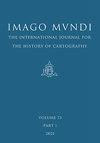Mapping Abundance for a Planetary Future: Kanaka Maoli and Critical Settler Cartographies in Hawai’i
IF 0.5
4区 历史学
Q4 GEOGRAPHY
Imago Mundi-The International Journal for the History of Cartography
Pub Date : 2022-01-02
DOI:10.1080/03085694.2022.2044187
引用次数: 8
Abstract
Mapping America: The Incredible Story opens with a prologue followed by ten chapters, an epilogue, further reading and a notes’ section. There is no index. The chapters are organized in a mix of chronological order spliced with topical interludes, starting with ‘The Dawn of the Renaissance’ and continuing with ‘The Discovery [sic] of the Americas’, ‘The First European Settlements’, ‘The Golden Age of Cartography’, ‘The Eighteenth-Century Colonization of America’, ‘Daily Life in the English Colonies’, ‘Mapping the Prelude to War’, ‘The Outbreak of Rebellion’, ‘The Battle for Independence’, and ‘The Road to Victory’. The authors have an ambitious goal claiming that ‘this book will tell the full story of America, from the Age of Discovery through the Revolutionary War... through the art of mapmaking’. There is a disconnect, though, between the stated aim and what is delivered, especially visually. One would reasonably expect a story about stunning maps to have many detailed close-ups of maps, or at least enough information to find out more about them. Yet few of the maps state where they are located or who supplied the images. Most such information is missing, including size and the version presented. While each of the 147 images (just over half are maps) is labelled as ‘Fig. 1, Fig. 2’ etc., none is directly referred to within the text, and the reader is left to hunt them down. Usually the figures are on the same page or within a page of where they are discussed, but sometimes a map is brought up in the narrative without a corresponding image. At other times the caption of an image tells a mini story about its relevance but will not otherwise be mentioned in the body of the text. For a book with the word ‘maps’ in the title, they are treated as if an afterthought. Certain aspects of the writing are disappointingly and cringingly dated, such as the use of the word ‘discovery’ without irony more than a dozen times, including as chapter and section headings. When telling a history of the process of the United States becoming a nation, the story is relayed with an openly biased perspective. The text refers to ‘we’ when addressing the presumed reader, who is clearly white, male, Christian and of European ancestry. For example, ‘North America before the arrival of Europeans was not the untamed land that we often believe it to be’. It would be a challenge to find an educated, indigenous or aware person who believes this today. There are gaps in the survey of historical mapping of the era purported to be covered thoroughly. For example, not a single Des Barres map is mentioned, which anyone studying this time period would expect to see. And there are false claims. For example, a map said to be never-before-published (Henri Soules [sic], Plan of the Battle of Yorktown, 1787) is easily found digitized and online. Examples of inconsistent captions, missing information and lack of credit abound. The Incredible Story is an attempt at a history of the early United States, not a history of cartography. Suffice it to say that this book is neither a contribution to the history of cartography nor a thorough survey. It can safely be skipped by map enthusiasts, researchers and teachers in favour of the many more comprehensive and well-researched books available on the same topic.为地球的未来绘制丰富的地图:夏威夷的Kanaka Maoli和关键的定居者制图
《映射美国:不可思议的故事》以序言开头,接着是十章、一篇结语、进一步阅读和一个注释部分。没有索引。各章以时间顺序与主题穿插相结合的方式组织,从“文艺复兴的黎明”开始,一直到“美洲的发现”、“第一批欧洲人的定居点”、“制图的黄金时代”、“18世纪美国的殖民”、“英国殖民地的日常生活”,《战争前奏图》、《叛乱爆发》、《独立之战》和《胜利之路》。作者们有一个雄心勃勃的目标,声称“这本书将讲述美国从发现时代到独立战争的全部故事……”。。。通过地图绘制艺术。然而,在既定目标和交付内容之间存在脱节,尤其是在视觉上。人们可以合理地期待一个关于令人惊叹的地图的故事会有许多详细的地图特写,或者至少有足够的信息来了解更多关于它们的信息。然而,很少有地图说明它们的位置或谁提供了图像。大多数此类信息都缺失了,包括尺寸和提供的版本。而147幅图像中的每一幅(略多于一半是地图)都被标记为“图。1,图2'等,文本中没有直接提及,读者可以自行查找。通常,这些数字在同一页上,或者在讨论它们的地方的一页内,但有时在叙事中会出现一张没有相应图像的地图。在其他时候,图片的标题告诉了一个关于其相关性的小故事,但不会在正文中提及。对于一本标题中有“地图”一词的书,它们被视为事后才想到的。写作的某些方面令人失望和尴尬地过时了,比如十几次使用“发现”一词而不带讽刺意味,包括作为章节标题。在讲述美国成为一个国家的过程时,故事是以公开的偏见视角讲述的。文本在称呼假定的读者时提到了“我们”,这位读者显然是白人、男性、基督徒和欧洲血统。例如,“欧洲人到来之前的北美并不是我们通常认为的未开垦之地”。今天,要找到一个受过教育、土著或有意识的人相信这一点,将是一个挑战。据称,在对那个时代的历史地图进行调查时,存在一些空白。例如,没有提到任何一张Des-Barres地图,任何研究这一时期的人都希望看到这张地图。还有一些虚假的说法。例如,一张据说从未出版过的地图(Henri Soules[原文如此],《约克镇战役计划》,1787年)很容易被数字化和在线找到。标题不一致、信息缺失和缺乏信用的例子比比皆是。《不可思议的故事》是对美国早期历史的一次尝试,而不是地图绘制史。可以说,这本书既不是对地图学史的贡献,也不是一本彻底的调查。地图爱好者、研究人员和教师可以放心地跳过它,转而选择关于同一主题的更全面、研究更深入的书籍。
本文章由计算机程序翻译,如有差异,请以英文原文为准。
求助全文
约1分钟内获得全文
求助全文
来源期刊
CiteScore
0.20
自引率
0.00%
发文量
32
期刊介绍:
The English-language, fully-refereed, journal Imago Mundi was founded in 1935 and is the only international, interdisciplinary and scholarly journal solely devoted to the study of early maps in all their aspects. Full-length articles, with abstracts in English, French, German and Spanish, deal with the history and interpretation of non-current maps and mapmaking in any part of the world. Shorter articles communicate significant new findings or new opinions. All articles are fully illustrated. Each volume also contains three reference sections that together provide an up-to-date summary of current developments and make Imago Mundi a vital journal of record as well as information and debate: Book Reviews; an extensive and authoritative Bibliography.

 求助内容:
求助内容: 应助结果提醒方式:
应助结果提醒方式:


